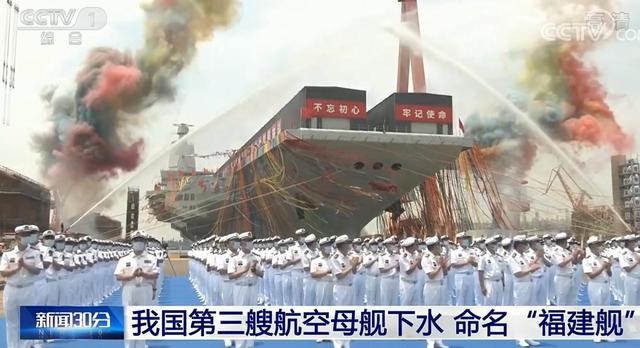| Naval Air: The Growing Chinese Carrier Force
海军航空兵:日益壮大的中国航母力量 Date:2022-07-20 Source:strategypage By:strategypage Viewed: |

July 18, 2022: A month ago China formally launched and named its third aircraft carrier, the 80,000-ton Fujian (CV-18). China confirmed that the Fujian is powered by steam turbines that generate the needed electrical power for its EMALS (electromagnetic aircraft launch system) in a conventionally powered carrier. Satellite photos had earlier shown that Fujian has three EMALS catapults. Fujian turned out to be larger than expected, in part because of the space needed for the IEP (integrated electric propulsion) system that supplied the power for EMALS. The only other carrier using EMALS is the American nuclear-powered USS Ford. China was more deliberate in designing their EMALS system and appears to have learned from the mistakes the Americans made.
2022年7月18日:一个月前,中国正式下水并命名其第三艘航空母舰,8万吨级的“福建”号(CV-18)。中国证实,“福建”号由蒸汽涡轮机提供动力,这些涡轮机在传统动力航母上为其电磁飞机弹射系统(EMALS)提供所需的电力。此前的卫星照片显示,“福建”号有三条EMALS弹射器。“福建”号比预期的要大,部分原因是为EMALS供电的IEP(集成电力推进)系统所需的空间。另一艘使用EMALS的航母是美国“福特”号核动力航母。中国在设计EMALS系统时更加慎重,似乎从美国犯的错误中吸取了教训。
At 300 meters (984 feet) Fujian appears to be nearly as long as the 333-meter Ford, which displaces about 100,000 tons. Fujian has a smaller crew and operates fewer aircraft. Because it is nuclear powered the Ford moves at higher speeds for sustained periods than the Fujian, which has to dedicate a lot of internal space for fuel. Fujian is expected to be ready for sea-trials by the end of 2022 and enter service in 2023 or 2024.
在300米(984英尺)的尺寸上,“福建”号似乎与333米的“福特”号差不多长,“福特”号的排水量约为10万吨。“福建”号的机组人员较少,舰载机数量也较少。因为它是核动力的,“福特”号在持续的一段时间内能以比“福建”号更快的速度航行,而“福建”号必须为燃料提供大量的内部空间。“福建”号预计将在2022年底前做好海试准备,并在2023年或2024年服役。
China already has two carriers in service; Liaoning (CV-16) and the similar Shandong (CV-17), which completed sea trials and entered service at the end of 2019, as it was seen moving past Taiwan. Back then it was assumed that China wanted to build two more similar carriers (CV-18 and 19) which would lose the ski jump deck and instead adopt a catapult. This was the case with Fujian (CV-18) that was already under construction in 2019, and in the water a year later. At that point it appeared that CV-18 would be in service by 2024 but details of its layout and displacement were still vague.
中国已经有两艘航母在役;“辽宁”号(CV-16)和类似的“山东”号(CV-17)于2019年底完成海试并服役,当时它正驶过台湾海峡。当时人们认为中国想再建造两艘类似的航母(CV-18和19),它们将去掉滑跃甲板,而是采用弹射器。“福建”号(CV-18)就是这种情况,2019年它已经在建,一年后下水。那时,CV-18似乎将在2024年服役,但其布局和排水量的细节仍然模糊不清。
It was believed that CV-18 might be delayed by the decision to use EMALS instead of steam catapults. The U.S. Navy has had problems getting its EMALS to work effectively and the Chinese were believed to be waiting to see how that works out before deciding. That was not the case as CV-18 was built with the IEP, which was only required if EMALS was used. What is unknown is if CV-19 will be similar to CV-18 or use nuclear-power. China has more problems with nuclear-powered surface ships than with EMALS. China has been working on nuclear propulsion for submarines for decades and encountered lots of technical problems that seriously limited the development of an effective Chinese nuclear submarine force. Chinese nuclear power experts informed the government that China did not yet have reliable nuclear power plants for surface ships and it would be a while before that technology was perfected.
人们认为,CV-18可能会因决定使用EMALS而不是蒸汽弹射器而推迟。美国海军在使其EMALS有效工作方面遇到了问题,据信,中国方面在做出决定之前正在等待结果。事实并非如此,因为CV-18是用IEP构建的,只有在使用EMALS时才需要IEP。目前尚不清楚的是,下一艘CV-19是否会与CV-18相似或使用核能。与EMALS相比,中国在核动力水面舰艇方面存在更多问题。几十年来,中国一直致力于潜艇的核动力推进,遇到了许多技术问题,严重限制了中国核潜艇部队的有效发展。中国核电专家告诉政府,中国还没有可靠的水面舰艇核反应堆,这项技术还需要一段时间才能完善。
With the official recognition of Fujian, it became clear that China probably would have five or six non-nuclear-powered carriers by 2030, with all but two of them based on the Fujian.
随着“福建”号的正式承认,很明显到2030年,中国可能会有五到六艘非核动力航母,其中除前两艘外,其余均以“福建”号为基础。
Since carriers spend a lot of time in port getting upgrades and maintenance, you need three or more in order to guarantee having at least two available at all times for operations. China has already built or is building enough escort and support ships, along with air wings, to keep several carrier task forces, each built around one carrier, busy while one or more carriers were sidelined by months of maintenance and upgrades. China announced in 2020 that their first carrier, a rebuilt Russian carrier, would not remain a training carrier but would be equipped and manned with a crew that would enable it to also serve as a combat carrier in an emergency.
由于航母在港口进行升级和维护方面花费大量时间,因此需要三艘或更多数量以确保始终有至少两艘可用。中国已经或正在建造足够的护航和支援舰艇以及航空联队,以维持数支航母特遣部队,每支航母特遣部队都围绕一艘航母建造,而一艘或多艘航母则因数月的维护和升级而被迫搁置。中国在2020年宣布,他们的第一艘航母是俄罗斯航母重建的,它将不再是训练航母,而是武装和配备船员,使其在紧急情况下也能作为战斗航母。
Fujian was not a complete surprise. As early as 2014 there were official photos of carrier model displayed at an official event. The detailed model had the hull number 18 and the ship looked similar to an American Nimitz class CVN. The Chinese CVN has four catapults and three elevators and much other evidence of being nuclear and very similar to the Nimitz class. This was an early Chinese Navy proposal for a CVN and that has apparently been refined to something that is similar to the Nimitz.
“福建”号并不完全令人惊讶。早在2014年,航母模型的官方照片就在官方活动中展出。详细模型的船体编号为18,该船看起来类似于美国尼米兹级CVN。中国CVN有四条弹射器和三部升降机,还有许多其他证据表明它是核动力的,与尼米兹级非常相似。这是中国海军早期提出的CVN方案,显然已经改进为类似于尼米兹级。
上一篇:Multi-domain operations demand multifunction sensors 下一篇:China sprinting ahead as a space power while US lacks ‘urgency,’ new report frets
| The Booker dilemma: inside US Army transformation
“布克”困境:美国陆军转型内幕 |
| The decision to cancel the M10 Booker light tank is at the core of a reordering of US Army planning.... [2025-07-16] |
| Focus: A fragile balance in Asia, China has become leading military power in the
焦点:亚洲平衡脆弱,中国已成为该地区的主要军事力量 |
| However, China's rapid military growth in this area is tipping the balance in favor of regional power. ... [2024-08-27] |
| Small drones will soon lose combat advantage, French Army chief says
法国陆军总司令表示,小型无人机将很快失去战斗优势 |
| By Rudy Ruitenberg Thursday, Jun 20, 2024 作者:鲁迪瑞滕伯格 2024年6月20日星期四 French Army Chief of Staff Gen. Pierre Schill inspecting a Rapid Eagle anti-drone system at the Eurosatory defense show in Paris on June 19, 202... [2024-08-18] |
| What’s next for Ukraine’s incursion into Russia?
乌克兰入侵俄罗斯的下一步是什么? |
| Ukraine’s forces have surprised us all with its recent incursion into Russia’s Kursk Oblast since the operation to turn the tide of the war,... [2024-08-17] |
